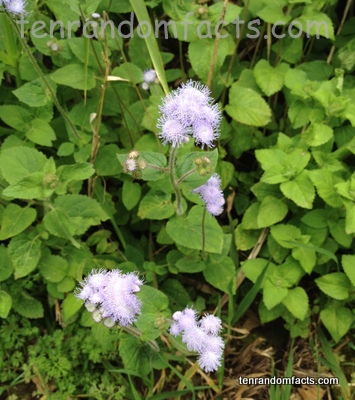Blue billygoat weed is a strange name for a strange plant.
- Blue billygoat weeds are an annual plant, native to areas of Central America and Mexico.
- Blue billygoat weeds have the scientific name Ageratum houstonianum and are from the family Asteraceae, the family of asters and daisies.
- ‘Blue billygoat weeds’ are also known as ‘blueweeds’, ‘floss flowers’, ‘blueminks’, ‘pussy foots’, ‘Mexican paintbrushes’ and ‘goatweeds’, among others.
- Blue billygoat weed typically grows to be 30 to 100 centimetres (1 to 3.3 feet) in height and the leaves grow to be 2 to 7 centimetres (0.8 to 2.8 inches) in length.
- Blue billygoat weed has small seeds that are coloured brown to black, and are covered in small scales that look like hairs.
- Blue billygoat weed is often used for ornamental purposes, such as in gardens, and some of the cultivars have been awarded the British Royal Horticultural Society’s Award of Garden Merit.
- The flowers of blue billygoat weed can be blue, pink, white or purple in colour, and the flower heads are covered with numerous, clustered, tiny tubular flowers, that are thread-like in appearance.
- Blue billygoat weed contains a chemical that causes premature moulting in insects, and they can be poisonous to animals such as sheep and cows, causing liver problems.
- Blue billygoat weed has been classified as an invasive weed in many areas, such as parts of the United States, Asia, New Zealand, Europe, Africa and Australia.
- Blue billygoat weeds are readily grown from seeds, that are easily spread in water and wind, and this is the main cause of its widespread weed status.
Bibliography:
Ageratum houstonianum, 2013, Wikipedia, http://en.wikipedia.org/wiki/Ageratum_houstonianum
Blue billygoat weed, 2011, Weeds of Australia, http://keyserver.lucidcentral.org/weeds/data/03030800-0b07-490a-8d04-0605030c0f01/media/Html/Ageratum_houstonianum.htm









Hi, I was wondering if this plant is ever found in the Pacific Northwest?